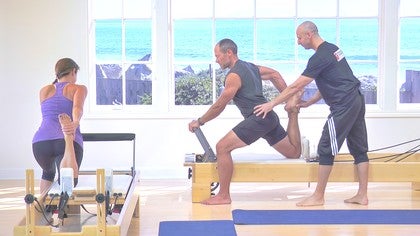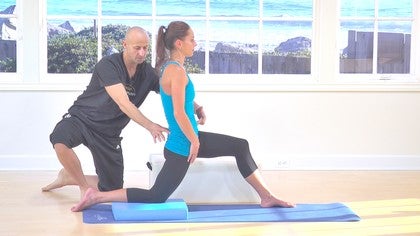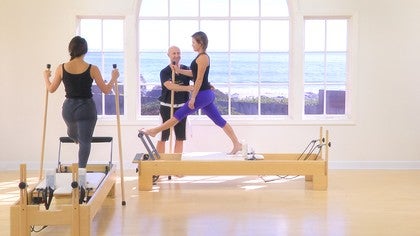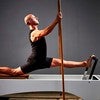Description
To see more of the contract and relax technique that Anthony teaches, you can watch Stretches for Tennis.
About This Video
Transcript
Read Full Transcript
I'm Anthony Litt from Australia and today we're going to do a class on stretching for goals. The work that we're doing today is, is not so much, um, traditional politeness, but it's, I guess it's honoring the idea of Joseph Pele's. Well, one of his ideas was that people would become as supple as a cat after working at his method and we sort of extending that idea today with some stretching work. Um, we're going to start off today I think with, with some work for the quadriceps and the glutes, which are working pretty hard in all golf swings, um, either statically or dynamically. And then we've got to work on some rotation for the trunk and then maybe finish off with, um, a bit of flection and ladder reflection for the spine. One of the things that you'll find with, um, golf players is if you're a player yourself, that you develop a lot of muscle imbalances or asymmetries with the nature of the sport itself where there's only really rotation in one direction. So if you find that that's the case with you, I'd probably recommend that you do the stretches to the tight side more often, say two or three times a week at least for a month or two, and even leave the looser side for a month or two so that you can address those imbalances. The other thing I want to just make you aware of before we get stretching is this technique called contract relax, which is, it's quite simple.
You take a group of muscles that you're stretching into a position where you feel a gentle stretch, say five or six out of 10 then we're going to hold that position for five breaths. And then what we do is we activate the muscles that we're stretching. So that sounds a bit confusing when I talk about it here, but when we start practicing the stretches, it will become clear as to what I'm talking about. So then we can track the muscles for five seconds. We relax, and then we try and re stretch for about 10 to 15 breaths, which is roughly a minute. Okay, so we're gonna start off this time. We're gonna work from the legs up and we're gonna start off by stretching the quadriceps. I think when you're playing golf, there's not a huge amount of flection, but there's a lot of static work done by the quadriceps and I'm sure because they're not taken through a full range of movement that they're probably quite tight in a lot of you. So what am I do, Andy, is I'll demonstrate to you just the start of the stretch so that you can get into position and then I'll talk you through the rest we do. This is pretty intense. They're stretched. So take it easy to start with.
The springs that I've got on are a green and a blue. And what you need to do to get into position is like take a hold of your ankle and see if he can put not your knee cap just above the knee in front of the shoulder, wrists, and the other foot is up here roughly in line with the bar. Okay. So that'll be your first position. And then I'll get you to into that position and then we'll, we'll go from there. Okay. So. Okay, so, so hold onto the bar and then grab your ankle and see if you can place your, your leg right up there against the shoulder is good. Okay.
If possible, avoid putting in a cap on the carrots just above it if you can. Okay. So there's your starting position. The first thing you do from here is try and square your hips. Okay. And for some people that might already be straight, she to getting any stretch yet. Okay. All right, good. Let's just hold that position for five breaths and then what we'll do is we'll contract or activate the quadricep muscles by pushing your foot back into your hand. Okay. So let's do that now. So I push not too hard, just one, two, three, four, five, stop. Take a breath in. And then as you breathe out safe, you can pull your foot closer towards the bottom.
Okay, so that's the second position. How are you both feeling with that? Do you want to make it stronger or is that enough? Okay. You do. Okay. So he said yes. So let's pull a foot writing towards your bottom. Good.
It does require a bit of work here in the arms. And then we're going to try and lower your hips and slide the carriage out a bit. Good. Now you notice, um, as Andy lowered his hips there, the foot came away a bit, so, so keep it in close to your bottom and then lower yourself. Okay, good. Okay. So it's pretty intense. We can you try and hold that for lace 10 breaths.
The other thing is that the air, the lead rope part of the quadriceps, they'll that run underneath the ITB. We can emphasize them a little more if you try rotating your hips further than square. Good. And just leaning your hips across a bit. Has there anything, did that move the stretch a bit, Sarah? Yeah. Good. And you, you just try and keep that food in clause has a
Good. So again, grab ahold of your ankle first and then see if you can place it just in front of the shoulder. Wrist, Yep. And then the other foot, Sarah, see if you can, that's it up there. Good. Okay. Good. Size. Square the hips first, and then once you've got the hips square, pull the foot towards your bottom.
You can swap hands if you want and it doesn't matter too much, so hold that position. Good. Now let's try contraction. So push your foot away from you because the quadriceps is such a big muscle group, you may want to contract for a bit longer, maybe six to eight seconds.
Remember the first part of the restraint is just to pull your foot in closer. Good. If you get your foot right up onto your bottom like Sarah has in it, can't go any further. Then the next part is to try and lower your hips and slide the carriage out a little. You don't have to, it just depends on how it's feeling. Good. This side a bit tighter. Randy, I'm just going to move your hips across a bit. So there and then I'll just lean on. Is that okay?
They work a lot to rotate your pelvis during a golf swing swing. Um, so we're going to do two different ones. One of them to target the smaller external, right? And then the second one, the logic glutes. Um, so what else do is I'll, I'll show you the first one to get into position. You just have your foot against the shoulder, wrist. And then sit onto the carriage this way. Okay.
So that's the first position. If you're very tight, you'll find that your muscles are pulling it back this way. Let's just see how you go getting the hips level to start with. Okay. Maybe. Yeah, if you try the right leg and Andy's gonna do, which one are you going to do the right one as well. Okay. All right. So you put your foot against the right shoulder. The this shoulder is, yeah. And then try and sit down onto the carriage. Good. Okay.
How is that any better than I expected you both getting a stretch? Yeah. Okay. As I said, some people will be, if you really tight, you're going to be here, but that's okay. Just hold the first position wherever you can. Okay. And you'll notice, um, the back leg, they both pushing with the back leg, which is really effective in keeping your pelvis tilted slightly forward, which is much better. It makes the stretch much more effective if you let your pelvis roll back the stretch all but disappears unless you really taught. Okay. So let's do a contraction. So push your foot down into the carriage.
So one the foot, this foot. Yep. Two, three, four, five, stop pushing. Take a breath in. And then we're going to try and lean the center of your chest towards that foot. So high over that way. So you can, yeah, that's the way. And I'll move your hip a little. Is that alright? Yeah.
So what I'm doing here is just trying to keep your hips level and tilted slightly anteriorly. How has that any, and is in a good position a lot of the time when I say lean your chest towards your foot, people will actually just, if you can just round your spine and go into that position, that's not really what I'm talking about because that actually lets you hips roll backwards. So keep it pelvis forward and laying your chest for good and then press with that back leg as much as you can.
Take a breath in. Now to re stretch Andy, it might be enough just to try and level your hips and straighten that leg without leaning forward. That might be enough of a restretch.
Have you been doing something with your left leg? And that's just okay. Seems to be a bit tighter. Okay. Now if you come out of the stretch, I'll demonstrate where usually you can do this as, as a sort of progression. But let's think of it today as two different stretches and they do feel quite different. I'll show you the second one might be easier if I'd come this way. So if you put the head rest down and what you do this time is put your foot onto the head rest and sit again.
So before we had the leg here on the knee was out there this time you stay where you are, but move your leg across so that your knee is now in line with your navel this way. Okay, so it's more abducted again, going to try and square the hips. Okay. That'll be the first position. And then once we can tract, we're going to go forward and then try to reach around this way. So I'm trying to get my, um, it, I have a here this way. Okay. But what's, what's most important is that we bring the hips around and this just assists with that. Okay. All right. Let's, let's, let's get into the first position and then we'll work from there. So foot onto the headrest.
Yeah, Andy, you can, yeah, try and that's better. Bring the foot right across. So now you're in a good position, the knees in line. And for some people that might be enough. So let's just hold that to start with. Are you both feeling a stretch? Normally it's a bit different. Yeah, a little higher and a bit more lateral. Okay. So let's contract.
So push your foot down into the headrest and the whole leg actually you can push down.
Okay, so let's, yeah, let's go lie over your leg. Reach the left hand around two here. Hold. Yeah, hold on. And then the top hand pushing into the bar so that what that does is assist with the rotation, which makes the stretch stronger in the hip. How's that feel? It's good. Okay. So what I'm doing is pushing this way to help get that hip around, but you don't have to have someone with you to get a pretty intense stretch is Andy Martin might test if he feeling that? Yeah, actually that's good.
Yeah. If you're pushing my left foot by my pump. Okay. I'll stay away. Good. And the good, the good thing about using the reformer is that you, you don't really have to use too much strength. You can use your body weight just to hold that position. All right. Why don't we lift out of it slowly
That could be enough for some people. If you want to make it more intense, you can do what both of these two are doing and that is to lean forward and reach around if you can do it. So this hand goes on here. You got to say, you're pulling with this hand as a, as a means of trying to get your hips around further. Good. And then the top hand is pushing in
Come out of the stretch and we're going to do some rotation for the spine. Um, what I might do is give Andy the floor version and Sarah you can do the the reformer version. So what we do here is might be best if I'm, if I go on here, we're going to start sitting this way with the legs against the shoulder, the um, the bar here, and that'll prevent your pelvis and lumbar spine from twisting too much and because there isn't much rotation available down there anyway, so we're anchoring here and then we're going to lift your chest rates around with this hand and hold the bar and the other hand goes onto the shoulder, wrist. Then what you do is lift your chest, good, lift the chest, and this hand is going to pull on the bar. This way, this hand is going to push in to to enable you to rotate that up. Aback that, okay. So if you're pulling the bar towards you, you're pulling in the wrong direction.
Not that you're doing that, but often you'll see people pulling it this way. It's actually this way. And that's what assists you in the rotation. Okay, good. So while you're holding that, I'll get Andy in position. Did one more thing is to try and pull the shoulder blades together because during that, and I will see your Pec minor muscle to assist with your breathing. Okay, good. So that's, can you hold that for a little while? And if you want to lie on your back and take the right arm up to here, straighten this leg, just shift the hips towards the middle of the Mat. Yeah, a little bit further. And then we're gonna rotate.
So put your foot on there and then rotate that way. Good. And what I can do here is just told you them and push a little. So I'm pushing this way and I'm also trying to lengthen the law back a little as well. Said. All right. Okay. So the, the stretch that Sarah is doing is probably more focused in the upper thoracic area. This one tends to be a bit lower down. All right, so let's do a contraction. So basically to contract, you're trying to twist yourself out of the stretch, so pushed back into this. Yeah. And you can push that arm up as well. One, two, three, four, five breathing and ray stretch.
Good. And if you want to put your hands here, you can push down a bit. If you've got any sandbags that harm, it's often a good idea just to put one here and one on the arm. Not the huge sex. I mean just a little yoga, sandbags. How are you going here? Did you understand the contraction of trying to twist back? Yeah, so it was really just engaging all the I Blake muscles to try and turn yourself back to the start. Yeah, pretty cool. Good.
Okay, let's roll out of it slowly and we'll try the other side. That was really bad. I really liked that a lot. Could. So as I said, if you find that if you're right handed and you're sweet, you're rotating a lot to the left while playing golf. You just do the uh, the opposing movement for a month or so to try and rectify some of those imbalances that looks good and you just try and make sure that this bottom leg is down the middle so that we're rotating right through the spine and not at a couple of different joints.
So lets do a contraction. So Andy, if you just push your leg up and say are you trying to twist back to the start? One, two, three, four, five, stop
This is good for those talkative students. Try and breathe deeply so that whatever space is available around the trunk will be opened up with the breath. I remember this hand pulling that way. I was relying on you. Yeah, that's okay.
I might just demonstrate first and then you can try and if I lie on here, I will do this on the floor. So what do you do here is lie down and put your arm. The elbow roughly is as high as my head. Okay. Then what I'm going to do is roll the opposite hip back this way. Okay. Just make sure as you roll back that your arms doesn't leave it.
It stays in contact with the floor and you, a common mistake with this is to have the um, either too high or too low. So let's start off with the elbow about as high as your ear or your head. Depends how big your is. A really? Okay. That's good. And you can bend your arm a bit. Yep. Good. So as much of the arm as possible in contact with the floor and then very slowly roll the opposite hip and leg backwards.
Good. How's that feel? The weight of this leg should just help you to stay in position. If you want to rotate it a bit further. And if you put your hand that there and lift that up and just push that hand down.
Just keep your head down if you can and take like there's none. If you take that leg back, it'll just help you to twist. Good. You both caught the whole of the upper arm and shoulder in contact with the floor, which is good. Okay, so let's just roll out of that slowly. Andy, do you want the mat or are you okay there?
Okay, so let's just hold that position. Remember not to try and, or to try not to let the arm, especially the front of your shoulder. Lift off the floor. Try and keep it in contact with the floor. Okay, so we'll contract. So push your, um, the arm that you're stretching down into the floor. One, two, three, four, five. Remember using only about half your maximum strength at the most. Take a breath in and roll back a little further.
You can do that by dropping the leg back and pushing the opposite hand down.
One for the side waist muscles, which remember the oblique muscles around right back here as well and they're always involved in rotation. So we're going to do some one side end and one flection just to loosen up the lower back muscles as well, which are often pretty stiff and tight and to try and distract the vertebral upbeat in the lumbar spine. Okay, so we've moved the reformers out of the way and we're going to use the ladder barrel because it's really effective for side bending and a bit of flection. At the end. I'm going to get Andy to sit up on there and the bottom leg is in front. No you're, you're right as you were and then the top leg behind.
If you can try and keep the legs straighten and if you tie it through here, through the glutes and TFL and so on, you might find that you feel the stretch down here and even down into the knee. If, um, if you're okay and if you lower yourself slowly, yeah, you can reach down to that bottom bar and then reach the top arm over. You can let your head relax as well. How does that feel? Is that a stretch? Yes. Yep. So as I said, the stretch could be anywhere between here and here and also around the oblique area and quadratus lumborum area or here and in the lats up here as well. Especially when I pull down on your arm. How does it feel? Okay.
So if you hang onto this, just turn your up around outwards a bit. That gives you, that gives you a bit more space in the shoulder joint. Does that feel okay? So I'm going to pull on this a little. I might sit on the floor and I'm going to pull on this bar a little bit this way until you tell me it's enough.
So we'd hold this five and then we're going to do a contraction where Andy's going to try three things. He's gonna pull on the bar. He's going to try and sit back up and he's going to push his legs back up as well.
Rolling this all the back a little and take some deep breaths into here and you might find that these are Blake and rectus abdominis muscles stretch a bit too.
Okay. You want to try the other side? Yes. Okay. I could do that next year. You just be walking around like this for the next 12 months. Fantastic. Let's do that next year.
I'll come down here again and you can hold onto this and what I'll do is just lean back and, and try and lengthen that I'm a bit, how's that? That's fair enough to start with. Yeah. Okay. So we'll do a contractions. Pull on the bar. Imagine that you're going to do a side lift and push your feet up. Good. Yeah. Take a breath in. Try and relax and I'll see if I can pull a little more.
You tell me when to stop.
And then let's go back the other way. You were a kid. Remember to try and keep breathing deeply. That'll assist in opening up the areas that are ty. Just stay there a bit longer and I'll, I'll, I'll get up. You can let go of that. Oh, you want to hold it? Yeah.
The white of that might be enough just to exaggerate the stretch. But with your breathing you'll find that the deeper you breathe, the more that this area will be expanded and the better the stretch the bottom park can expand. Very much. So all of this area will be opened up. Okay. I'll take that. You can roll forward.
So good. So you're, the top of your pelvis is roughly on top of the barrel. It takes a little while before this stretch in some people, before they feel anything. Are you feeling any anything down here? Yeah. Yeah. So the weight of your legs is going to be pulling and I could pull down a little,
You can see his hips coming up and they'll really separate the vertebra down in the lower back. And that's really what we're trying to do. How does that feel? You can let your arms hang if you want. So deep breath, you don't have to have every breath, a deep breath, but maybe every second one even. Do you want me to pull on your legs or is it enough? Okay. Connie's high maintenance sandy.
Thanks. Okay, thanks.
Feel the Length - Playlist 1: Innovations in Pilates
Comments
You need to be a subscriber to post a comment.
Please Log In or Create an Account to start your free trial.
























